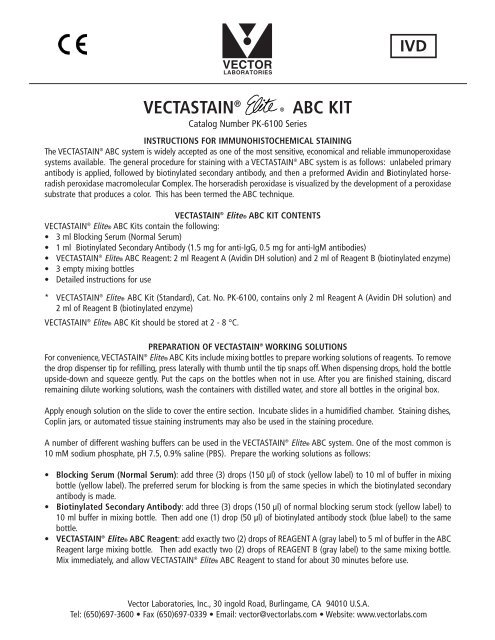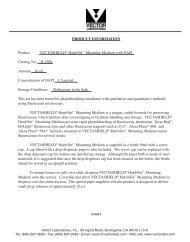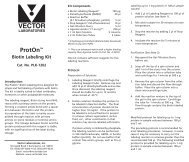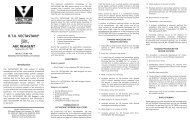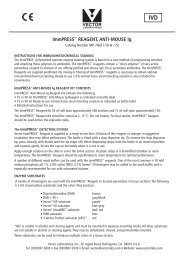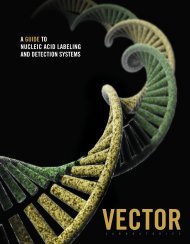Protocol (CE) - Vector Laboratories
Protocol (CE) - Vector Laboratories
Protocol (CE) - Vector Laboratories
You also want an ePaper? Increase the reach of your titles
YUMPU automatically turns print PDFs into web optimized ePapers that Google loves.
VECTOR<br />
LABORATORIES<br />
IVD<br />
VECTASTAIN ® ® ABC KIT<br />
Catalog Number PK-6100 Series<br />
INSTRUCTIONS FOR IMMUNOHISTOCHEMICAL STAINING<br />
The VECTASTAIN ® ABC system is widely accepted as one of the most sensitive, economical and reliable immunoperoxidase<br />
systems available. The general procedure for staining with a VECTASTAIN ® ABC system is as follows: unlabeled primary<br />
antibody is applied, followed by biotinylated secondary antibody, and then a preformed Avidin and Biotinylated horseradish<br />
peroxidase macromolecular Complex. The horseradish peroxidase is visualized by the development of a peroxidase<br />
substrate that produces a color. This has been termed the ABC technique.<br />
VECTASTAIN ® Elite® ABC KIT CONTENTS<br />
VECTASTAIN ® Elite® ABC Kits contain the following:<br />
• 3 ml Blocking Serum (Normal Serum)<br />
• 1 ml Biotinylated Secondary Antibody (1.5 mg for anti-IgG, 0.5 mg for anti-IgM antibodies)<br />
• VECTASTAIN ® Elite® ABC Reagent: 2 ml Reagent A (Avidin DH solution) and 2 ml of Reagent B (biotinylated enzyme)<br />
• 3 empty mixing bottles<br />
• Detailed instructions for use<br />
* VECTASTAIN ® Elite® ABC Kit (Standard), Cat. No. PK-6100, contains only 2 ml Reagent A (Avidin DH solution) and<br />
2 ml of Reagent B (biotinylated enzyme)<br />
VECTASTAIN ® Elite® ABC Kit should be stored at 2 - 8 °C.<br />
PREPARATION OF VECTASTAIN ® WORKING SOLUTIONS<br />
For convenience, VECTASTAIN ® Elite® ABC Kits include mixing bottles to prepare working solutions of reagents. To remove<br />
the drop dispenser tip for refilling, press laterally with thumb until the tip snaps off. When dispensing drops, hold the bottle<br />
upside-down and squeeze gently. Put the caps on the bottles when not in use. After you are finished staining, discard<br />
remaining dilute working solutions, wash the containers with distilled water, and store all bottles in the original box.<br />
Apply enough solution on the slide to cover the entire section. Incubate slides in a humidified chamber. Staining dishes,<br />
Coplin jars, or automated tissue staining instruments may also be used in the staining procedure.<br />
A number of different washing buffers can be used in the VECTASTAIN ® Elite® ABC system. One of the most common is<br />
10 mM sodium phosphate, pH 7.5, 0.9% saIine (PBS). Prepare the working solutions as follows:<br />
• Blocking Serum (Normal Serum): add three (3) drops (150 µl) of stock (yellow label) to 10 ml of buffer in mixing<br />
bottle (yellow label). The preferred serum for blocking is from the same species in which the biotinylated secondary<br />
antibody is made.<br />
• Biotinylated Secondary Antibody: add three (3) drops (150 µl) of normal blocking serum stock (yellow label) to<br />
10 ml buffer in mixing bottle. Then add one (1) drop (50 µl) of biotinylated antibody stock (blue label) to the same<br />
bottle.<br />
• VECTASTAIN ® Elite® ABC Reagent: add exactly two (2) drops of REAGENT A (gray label) to 5 ml of buffer in the ABC<br />
Reagent large mixing bottle. Then add exactly two (2) drops of REAGENT B (gray label) to the same mixing bottle.<br />
Mix immediately, and allow VECTASTAIN ® Elite® ABC Reagent to stand for about 30 minutes before use.<br />
<strong>Vector</strong> <strong>Laboratories</strong>, Inc., 30 ingold Road, Burlingame, CA 94010 U.S.A.<br />
Tel: (650)697-3600 • Fax (650)697-0339 • Email: vector@vectorlabs.com • Website: www.vectorlabs.com
ENZYME SUBSTRATES<br />
A variety of chromogens are used with the VECTASTAIN ® Elite® ABC system to visualize peroxidase in tissue sections. Here<br />
is a list of peroxidase substrates and the colors they produce:<br />
• Diaminobenzidine (DAB) brown<br />
• DAB + Ni 2+ gray/black<br />
• <strong>Vector</strong> ® VIP substrate purple<br />
• <strong>Vector</strong> ® SG substrate blue-gray<br />
• <strong>Vector</strong> ® NovaRED substrate dark red<br />
• TMB substrate blue<br />
• 3-amino-9-ethyl carbazole (AEC)* red<br />
* AEC is soluble in alcohol and clearing agents and must be mounted in aqueous mounting media. All other substrates<br />
are not soluble in alcohol or clearing agents. They may be dehydrated, cleared, and permanently mounted.<br />
These substrates can be used to introduce multiple colors in a tissue section.<br />
STAINING PRO<strong>CE</strong>DURE FOR PARAFFIN SECTIONS<br />
1. Deparaffinize and hydrate tissue sections through xylenes or other clearing agents and graded alcohol series.<br />
2. Rinse for 5 minutes in tap water.<br />
3. If quenching of endogenous peroxidase activity is required, incubate the sections for 30 minutes in 0.3% H 2 O 2 in<br />
either methanol or water. Incubation times may be shortened by using higher concentrations of H 2 O 2 . If endogenous<br />
peroxidase activity does not present a problem, this step may be omitted.<br />
4. Wash in buffer for 5 minutes.<br />
5. Incubate sections for 20 minutes with diluted normal blocking serum.<br />
6. Blot excess serum from sections.<br />
7. Incubate sections for 30 minutes with primary antibody diluted in buffer.<br />
8. Wash slides for 5 minutes in buffer.<br />
9. Incubate sections for 30 minutes with diluted biotinylated secondary antibody.<br />
10.Wash slides for 5 minutes in buffer.<br />
11.Incubate sections for 30 minutes with VECTASTAIN ® Elite® ABC Reagent.<br />
12.Wash slides for 5 minutes in buffer.<br />
13.Incubate sections in peroxidase substrate solution until desired stain intensity develops.<br />
14.Rinse sections in tap water.<br />
15.Counterstain, clear and mount.<br />
*If antigen unmasking is required, perform this procedure after step 2, using Antigen Unmasking Solution, Cat. No. H-3300.<br />
STAINING PRO<strong>CE</strong>DURE FOR FROZEN SECTIONS<br />
This procedure is generally appropriate for frozen sections, cell smears or cytocentrifuge preparations.<br />
1. Sections are air dried.<br />
2. Immediately before staining, fix sections with acetone or the appropriate fixative for the antigen under study.<br />
3. Transfer slides into buffer.<br />
4. If quenching of endogenous peroxidase is required, use gentle H 2 O 2 blocking to reduce the risk of antigen destruction<br />
or tissue loss: 0.3% H 2 O 2 in 0.3% normal serum in PBS for 5 minutes; or 0.3% H 2 O 2 in methanol for 30 minutes, or<br />
use other published methods (eg. Andrew, S. M., Jasani, B., Histochem J. 1987, 19, 426-30). If necessary, H 2 O 2 treatment<br />
may also be performed after the biotinylated secondary antibody step.<br />
5. Follow steps 4-15 of the procedure recommended for paraffin sections.<br />
If unwanted staining occurs in the absence of biotinylated secondary antibody, endogenous biotin may be present in the<br />
tissue. To eliminate this unwanted staining, use an Avidin/Biotin blocking step (Cat. No. SP-2001) between steps 6 and 7.<br />
DISPOSAL OF REAGENTS<br />
Flush to sewer if allowed or dispose of reagents according to local regulations. MSDS available online at:<br />
www.vectorlabs.com.<br />
For Professional Use Only.<br />
Authorized Representative:<br />
<strong>Vector</strong> <strong>Laboratories</strong> Ltd.,<br />
3 Accent Park, Bakewell Road, Orton Southgate<br />
Peterborough, PE2 6XS, United Kingdom,<br />
Tel: (01733) 237999 • Fax: (01733) 237119<br />
Revised 5/6/05


